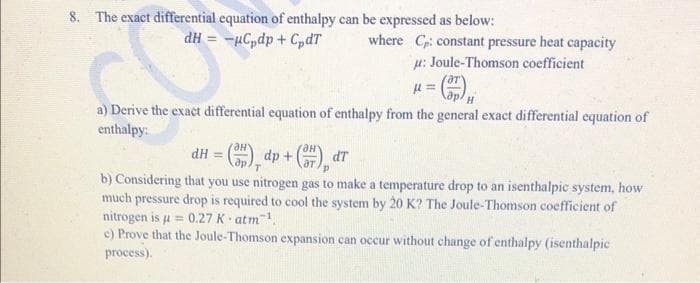The exact differential equation of enthalpy can be expressed as below: dH=-uCpdp + CdT where C: constant pressure heat capacity u: Joule-Thomson coefficient μl= H a) Derive the exact differential equation of enthalpy from the general exact differential equation of enthalpy: dp + (7) dr T dH= Р b) Considering that you use nitrogen gas to make a temperature drop to an isenthalpic system, how much pressure drop is required to cool the system by 20 K? The Joule-Thomson coefficient of nitrogen is µ = 0.27 K atm¹. c) Prove that the Joule-Thomson expansion can occur without change of enthalpy (isenthalpic process).
The exact differential equation of enthalpy can be expressed as below: dH=-uCpdp + CdT where C: constant pressure heat capacity u: Joule-Thomson coefficient μl= H a) Derive the exact differential equation of enthalpy from the general exact differential equation of enthalpy: dp + (7) dr T dH= Р b) Considering that you use nitrogen gas to make a temperature drop to an isenthalpic system, how much pressure drop is required to cool the system by 20 K? The Joule-Thomson coefficient of nitrogen is µ = 0.27 K atm¹. c) Prove that the Joule-Thomson expansion can occur without change of enthalpy (isenthalpic process).
Principles of Heat Transfer (Activate Learning with these NEW titles from Engineering!)
8th Edition
ISBN:9781305387102
Author:Kreith, Frank; Manglik, Raj M.
Publisher:Kreith, Frank; Manglik, Raj M.
Chapter10: Heat Exchangers
Section: Chapter Questions
Problem 10.19P
Related questions
Question

Transcribed Image Text:8. The exact differential equation of enthalpy can be expressed as below:
dH=-uCpdp + C₂dT where C: constant pressure heat capacity
u: Joule-Thomson coefficient
μl=
a) Derive the exact differential equation of enthalpy from the general exact differential equation of
enthalpy:
= (3), dp + (7) dr
T
dH =
b) Considering that you use nitrogen gas to make a temperature drop to an isenthalpic system, how
much pressure drop is required to cool the system by 20 K? The Joule-Thomson coefficient of
nitrogen is u 3 0.27 K atm¹.
c) Prove that the Joule-Thomson expansion can occur without change of enthalpy (isenthalpic
process).
Expert Solution
This question has been solved!
Explore an expertly crafted, step-by-step solution for a thorough understanding of key concepts.
Step by step
Solved in 4 steps with 1 images

Knowledge Booster
Learn more about
Need a deep-dive on the concept behind this application? Look no further. Learn more about this topic, mechanical-engineering and related others by exploring similar questions and additional content below.Recommended textbooks for you

Principles of Heat Transfer (Activate Learning wi…
Mechanical Engineering
ISBN:
9781305387102
Author:
Kreith, Frank; Manglik, Raj M.
Publisher:
Cengage Learning

Principles of Heat Transfer (Activate Learning wi…
Mechanical Engineering
ISBN:
9781305387102
Author:
Kreith, Frank; Manglik, Raj M.
Publisher:
Cengage Learning